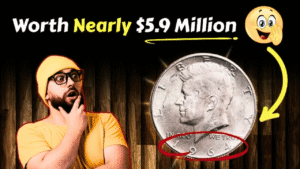Could a dollar coin in your pocket be worth a fortune? A rare Sacagawea dollar sold for $1.2 million at a 2025 auction due to a unique minting error. These golden coins, often mistaken for tokens, might be hiding in your wallet or a vending machine. This guide explores the coin’s history, the mistake that made it legendary, and how you can spot a million-dollar treasure.
The Story of the Sacagawea Dollar
Honoring a Native American Hero
Introduced in 2000, the Sacagawea dollar celebrates the Shoshone woman who guided Lewis and Clark’s expedition. With her portrait on the front and an eagle on the back, it’s a nod to American history. Its golden shine comes from a copper core coated in manganese-brass.
Why It’s Special
Unlike common coins, the Sacagawea dollar never caught on for everyday use. Many ended up in collections or storage, making them a collector’s favorite. Their unique look and historical significance spark excitement for treasure hunters.
The Million-Dollar Minting Mistake
The Mule Error Explained
The $1.2 million Sacagawea dollar is a “mule” error from 2000. A few coins were accidentally struck with the front of a Sacagawea dollar and the back of a Washington quarter. This mismatch, rare and unintended, makes these coins incredibly valuable.
A Collector’s Dream
Only about 20 of these mule error coins are known to exist. One, graded MS-67 for near-perfect condition, fetched $1.2 million in 2025. The rarity and the story behind the error drive its sky-high value.
Key Features of the Mule Error Coin
Here’s what sets the rare coin apart:
| Feature | Standard Sacagawea Dollar | Rare Mule Error Coin |
|---|---|---|
| Obverse Design | Sacagawea portrait | Sacagawea portrait |
| Reverse Design | Soaring eagle | Washington quarter eagle |
| Year | 2000 or later | 2000 |
| Material | Manganese-brass clad | Manganese-brass clad |
| Estimated Value | $1–$5 | Up to $1.2 million |
How to Spot a Valuable Sacagawea Dollar
Step-by-Step Guide
Finding a rare Sacagawea dollar takes a keen eye. Follow these steps:
- Check the Year: Look for 2000 on the front.
- Inspect the Reverse: A Washington quarter eagle (not the soaring eagle) signals a mule error.
- Examine Condition: Pristine coins with no wear are worth more.
- Look for Mint Marks: A “P” (Philadelphia) mark under the year is key for 2000 errors.
- Verify Weight: Should be around 8.1 grams, like standard Sacagawea dollars.
Tools You’ll Need
- A magnifying glass to inspect designs and mint marks.
- A precise scale to check weight.
- A coin guidebook or app for reference.
- Access to grading services like PCGS or NGC for authentication.
Where to Look
Search loose change, bank rolls, or vending machine returns. Old coin jars, estate sales, or family collections are also hot spots. Handle potential finds carefully to preserve value.
Are These Coins Still in Circulation?
The Thrill of the Hunt
Yes, these $1.2 million coins could still be out there. As legal tender, they might appear in everyday change. Stories of finds in gas stations or old piggy banks keep collectors hopeful.
Real-Life Discoveries
In 2000, a collector found a mule error coin in a bank roll, later valued at $66,000. Another surfaced in a California arcade in 2025, mistaken for a token, and sold for millions. These tales prove treasures can hide in plain sight.
Other Valuable Sacagawea Dollars to Watch For
Beyond the Mule Error
Not just mule errors are valuable. Look for these:
- 2000-P Cheerios Dollar: Included in Cheerios boxes, with a bold eagle design; worth $5,000–$12,000.
- 1999 Prototype: Struck before official release, possibly in gold alloy; fewer than 5 exist, valued up to $1.2 million.
- 2000 on Susan B. Anthony Planchet: Copper-nickel error; worth $820,000.
Condition Is Key
Coins graded MS-65 or higher by PCGS or NGC fetch the highest prices. Even non-error 2000 coins in pristine condition can sell for $10–$50.
Tips for Protecting and Selling Your Coin
Preserve Its Value
Never clean a coin—it lowers its worth. Store it in a plastic capsule or acid-free holder. Keep it away from moisture to avoid tarnishing.
Get It Authenticated
Take your coin to a reputable coin shop or grading service. They’ll verify authenticity and grade its condition. Watch out for counterfeits or altered coins.
Selling Options
- Auctions: Heritage Auctions or Stack’s Bowers for top dollar.
- Coin Dealers: Quick sales, but prices may be lower.
- Online Marketplaces: eBay or numismatic forums, but ensure authenticity to avoid scams.
FAQs About Sacagawea Dollars
1. How do I know if my Sacagawea dollar is a mule error?
Check for a 2000 date and a Washington quarter eagle on the back. Get it appraised by PCGS or NGC to confirm.
2. Are all 2000 Sacagawea dollars valuable?
No, most are worth $1–$5 unless they have a mule error, Cheerios design, or other rare features.
3. Can I find these coins in circulation?
Yes, they’re legal tender and could appear in change, bank rolls, or old collections, though it’s rare.
4. What’s a Cheerios Sacagawea dollar?
A 2000 promotional coin with a detailed eagle, distributed in Cheerios boxes; worth $5,000–$12,000 in good condition.
5. Where should I sell a valuable Sacagawea dollar?
Use auction houses, trusted coin dealers, or graded online sales. Always authenticate first to maximize value.
Start Your Sacagawea Treasure Hunt Today
A Sacagawea dollar might look like just another coin, but it could be worth $1.2 million. With rare mule errors and Cheerios coins still out there, every golden dollar is worth a second glance. Grab a magnifying glass, check your change, and hunt for that Washington quarter reverse. Your next vending machine transaction could lead to a life-changing payday. Start searching now—who knows what treasure you’ll find!




